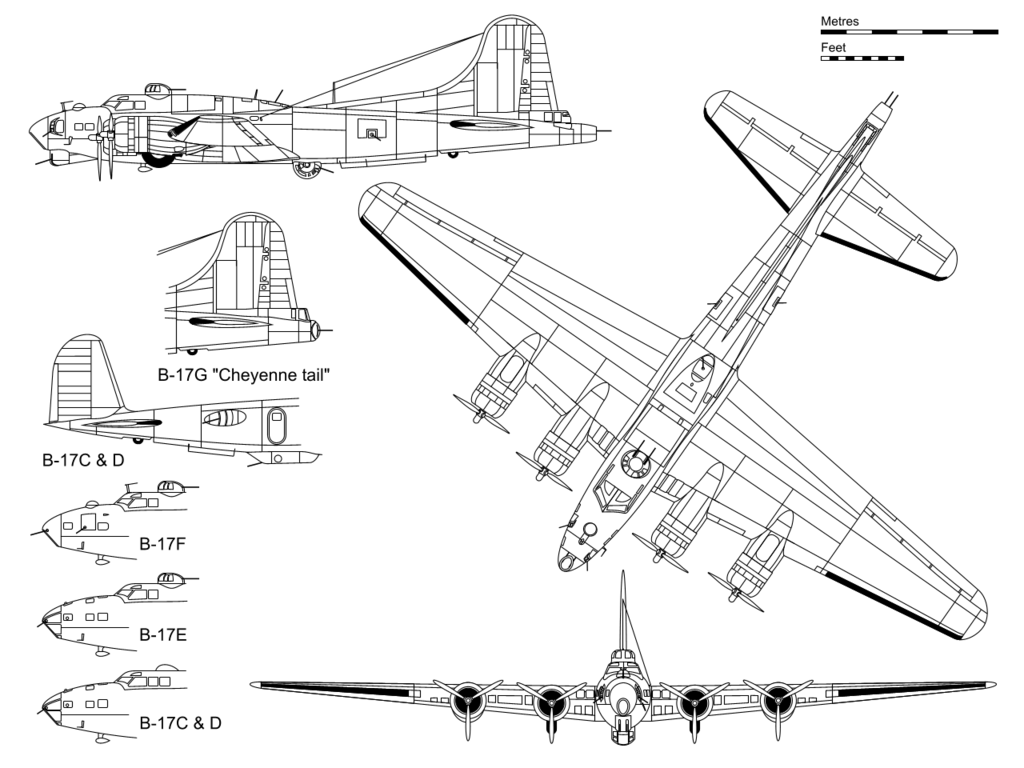Published Jul 26th, 2014, 7/26/14 1:21 pm
- 3,630 views, 3 today
- 25
- 8
- 14
110
The Boeing B-17 Flying Fortress is a four-engine heavy bomber aircraft developed in the 1930s for the United States Army Air Corps (USAAC). Competing against Douglas and Martin for a contract to build 200 bombers, the Boeing entry outperformed both competitors and exceeded the Air Corps' expectations. Although Boeing lost the contract because the prototype crashed, the Air Corps was so impressed with Boeing's design that they ordered 13 more B-17s for further evaluation. From its introduction in 1938, the B-17 Flying Fortress evolved through numerous design advances.
The B-17 was primarily employed by the United States Army Air Forces (USAAF) in the daylight precision strategic bombing campaign of World War II against German industrial and military targets. The United States Eighth Air Force, based at many airfields in southern England, and the Fifteenth Air Force, based in Italy, complemented the RAF Bomber Command's nighttime area bombing in the Combined Bomber Offensive to help secure air superiority over the cities, factories and battlefields of Western Europe in preparation for the invasion of France in 1944. The B-17 also participated to a lesser extent in the War in the Pacific, early in World War II, where it conducted raids against Japanese shipping and airfields.
From its pre-war inception, the USAAC (later USAAF) touted the aircraft as a strategic weapon; it was a potent, high-flying, long-range bomber that was able to defend itself, and to return home despite extensive battle damage. Its reputation quickly took on mythic proportions, and widely circulated stories and photos of notable numbers and examples of B-17s surviving battle damage increased its iconic status. With a service ceiling greater than any of its Allied contemporaries, the B-17 established itself as an effective weapons system, dropping more bombs than any other U.S. aircraft in World War II. Of the 1.5 million metric tons of bombs dropped on Germany and its occupied territories by U.S. aircraft, 640,000 tons were dropped from B-17s.
As of September 2011, 13 aircraft remain airworthy, with dozens more in storage or on static display.
The aircraft went through several alterations in each of its design stages and variants. Of the 13 YB-17s ordered for service testing, 12 were used by the 2nd Bomb Group of Langley Field, Virginia, to develop heavy bombing techniques, and the 13th was used for flight testing at the Material Division at Wright Field, Ohio. Experiments on this aircraft led to the use of a quartet of turbo-superchargers which would become standard on the B-17 line. A 14th aircraft, the YB-17A, originally destined for ground testing only and upgraded with the turbochargers, was re-designated B-17A after testing had finished.

General characteristics
Performance
Armament
---
Server: Esterlon Community Server
IP: 37.187.128.234:27260
Built by: Kroindaal
---
Refrence: https://en.wikipedia.org/wiki/Boeing_B-17_Flying_Fortress

This work by Kroindaal is licensed under a Creative Commons Attribution-NonCommercial-NoDerivatives 4.0 International License.
Based on a work at http://esterlon.enjin.com/home.
Permissions beyond the scope of this license may be available at Kroindaal's PMC.
The B-17 was primarily employed by the United States Army Air Forces (USAAF) in the daylight precision strategic bombing campaign of World War II against German industrial and military targets. The United States Eighth Air Force, based at many airfields in southern England, and the Fifteenth Air Force, based in Italy, complemented the RAF Bomber Command's nighttime area bombing in the Combined Bomber Offensive to help secure air superiority over the cities, factories and battlefields of Western Europe in preparation for the invasion of France in 1944. The B-17 also participated to a lesser extent in the War in the Pacific, early in World War II, where it conducted raids against Japanese shipping and airfields.
From its pre-war inception, the USAAC (later USAAF) touted the aircraft as a strategic weapon; it was a potent, high-flying, long-range bomber that was able to defend itself, and to return home despite extensive battle damage. Its reputation quickly took on mythic proportions, and widely circulated stories and photos of notable numbers and examples of B-17s surviving battle damage increased its iconic status. With a service ceiling greater than any of its Allied contemporaries, the B-17 established itself as an effective weapons system, dropping more bombs than any other U.S. aircraft in World War II. Of the 1.5 million metric tons of bombs dropped on Germany and its occupied territories by U.S. aircraft, 640,000 tons were dropped from B-17s.
As of September 2011, 13 aircraft remain airworthy, with dozens more in storage or on static display.
| Role | Heavy bomber |
|---|---|
| National origin | United States |
| Manufacturer | Boeing |
| First flight | 28 July 1935 |
| Introduction | April 1938 |
| Retired | 1968 (Brazilian Air Force) |
| Primary users | United States Army Air Forces Royal Air Force |
| Produced | 1936–1945 |
| Number built | 12,731 |
| Unit cost | US$238,329 |
| Variants | XB-38 Flying Fortress YB-40 Flying Fortress C-108 Flying Fortress |
| Developed into | Boeing 307 |
The aircraft went through several alterations in each of its design stages and variants. Of the 13 YB-17s ordered for service testing, 12 were used by the 2nd Bomb Group of Langley Field, Virginia, to develop heavy bombing techniques, and the 13th was used for flight testing at the Material Division at Wright Field, Ohio. Experiments on this aircraft led to the use of a quartet of turbo-superchargers which would become standard on the B-17 line. A 14th aircraft, the YB-17A, originally destined for ground testing only and upgraded with the turbochargers, was re-designated B-17A after testing had finished.

General characteristics
- Crew: 10: Pilot, co-pilot, navigator, bombardier/nose gunner, flight engineer/top turret gunner, radio operator, waist gunners (2), ball turret gunner, tail gunner
- Length: 74 ft 4 in (22.66 m)
- Wingspan: 103 ft 9 in (31.62 m)
- Height: 19 ft 1 in (5.82 m)
- Wing area: 1,420 sq ft (131.92 m2)
- Airfoil: NACA 0018 / NACA 0010
- Aspect ratio: 7.57
- Empty weight: 36,135 lb (16,391 kg)
- Loaded weight: 54,000 lb (24,500 kg)
- Max. takeoff weight: 65,500 lb (29,700 kg)
- Powerplant: 4 × Wright R-1820-97 "Cyclone" turbosupercharged radial engines, 1,200 hp (895 kW) each
Performance
- Maximum speed: 287 mph (249 kn, 462 km/h)
- Cruise speed: 182 mph (158 kn, 293 km/h)
- Range: 2,000 mi (1,738 nmi, 3,219 km) with 2,700 kg (6,000 lb) bombload
- Service ceiling: 35,600 ft (10,850 m)
- Rate of climb: 900 ft/min (4.6 m/s)
- Wing loading: 38.0 lb/sq ft (185.7 kg/m2)
- Power/mass: 0.089 hp/lb (150 W/kg)
Armament
- Guns: 13 × .50 in (12.7 mm) M2 Browning machine guns in 8 positions (2 in the Bendix chin turret, 2 on nose cheeks, two staggered waist guns, 2 in upper Sperry turret, 2 in Sperry ball turret in belly, 2 in the tail and one in the nose)
- Bombs:
- Short range missions (<400 mi): 8,000 lb (3,600 kg)
- Long range missions (≈800 mi): 4,500 lb (2,000 kg)
- Overload: 17,600 lb (7,800 kg)
- Short range missions (<400 mi): 8,000 lb (3,600 kg)
---
Server: Esterlon Community Server
IP: 37.187.128.234:27260
Built by: Kroindaal
---
Refrence: https://en.wikipedia.org/wiki/Boeing_B-17_Flying_Fortress

This work by Kroindaal is licensed under a Creative Commons Attribution-NonCommercial-NoDerivatives 4.0 International License.
Based on a work at http://esterlon.enjin.com/home.
Permissions beyond the scope of this license may be available at Kroindaal's PMC.
| Progress | 100% complete |
| Tags |
3006171
2


















![[ECS] SH-60 Seahawk Helicopter Minecraft Map & Project](https://static.planetminecraft.com/files/resource_media/screenshot/1503/hawk18551841_thumb.jpg)
![[ECS] Schwerer Gustav Railway Gun Minecraft Map & Project](https://static.planetminecraft.com/files/resource_media/screenshot/1449/gusthumb8404716_thumb.jpg)
![[ECS] Cougar (HE) MRAP | Veterans Day Special Minecraft Map & Project](https://static.planetminecraft.com/files/resource_media/screenshot/1446/mrap18322561_thumb.jpg)
![[ECS] C-36 Vector Specialized Attack Craft Minecraft Map & Project](https://static.planetminecraft.com/files/resource_media/screenshot/1444/craft18289299_thumb.jpg)
![[ECS] DS-42 "Mars" Military Spacecraft Minecraft Map & Project](https://static.planetminecraft.com/files/resource_media/screenshot/1437/craft18125613_thumb.jpg)
![[ECS] C-36 Vector Specialized Attack Craft](https://static.planetminecraft.com/files/resource_media/screenshot/1444/small/craft18289299_thumb.jpg)
![[ECS] DS-42 "Mars" Military Spacecraft](https://static.planetminecraft.com/files/resource_media/screenshot/1437/small/craft18125613_thumb.jpg)
![[ECS] Messerschmitt Bf 109 (Me-109) Fighter](https://static.planetminecraft.com/files/resource_media/screenshot/1430/small/me17901216_thumb.jpg)





![Ptichka (Buran) OK-1.02 [1:1] Minecraft Map & Project](https://static.planetminecraft.com/files/image/minecraft/project/2024/597/18010184_s.jpg)
Create an account or sign in to comment.
http://www.aerovintage.com/23354-2a.jpg